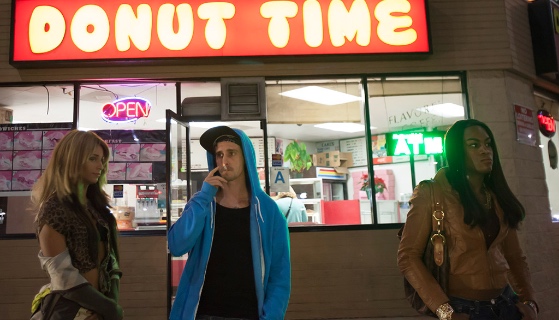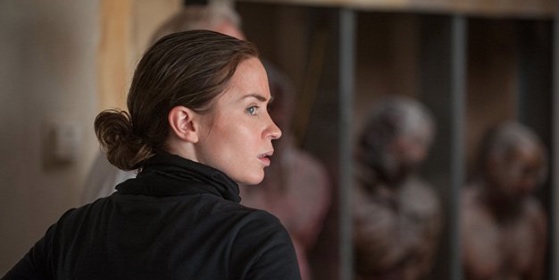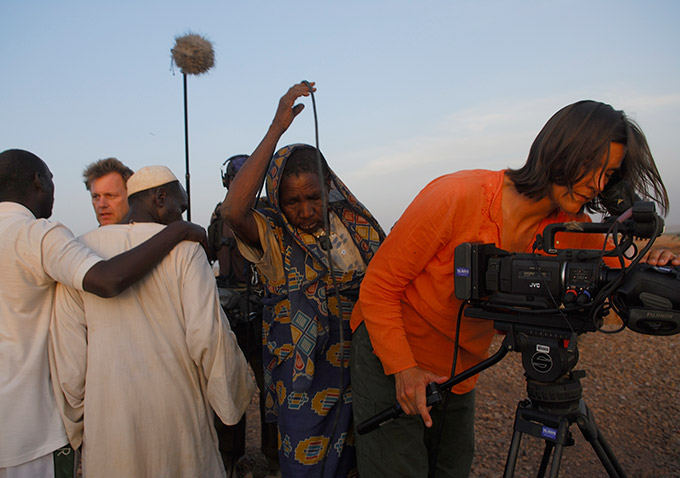
With a devilish grin and a wry look in her eyes, Sin-Dee (Kitana Kiki Rodriguez) strides out of a banana-coloured diner with one goal in mind: revenge. Sin-Dee has just been released from prison and, after catching-up with her best pal Alexandra (Mya Taylor), learns that her boyfriend, Chester (James Ransone), has cheated on her with a white “fish” (a cisgender woman). As Sin-Dee hits the streets searching for Chester, her high-heeled stomp is accompanied by gunshot trap beats as the camera careens while trying to catch up to her purposeful walk; the camera can barely keep up with this larger-than-life, hyper-active, get-things-done, no-bullshit kind of woman. Alexandra, by contrast, is introduced in a completely different manner. The calmer of the two, she chases after Sin-Dee, begging her not to cause any drama. With that promise well on its way to being broken, the camera follows Alexandra in a more languid manner. Everything slows down and the veering camera is replaced by a confident swaying that matches Alexandra’s pace by peering over her shoulder as she follows her friend in a state of loving exasperation.
The first five minutes of Sean Baker’s Tangerine (2015) offer a sight rarely seen in film: diversity in how trans women are treated through cinematic visual language. The film’s above cold open frames Sin-Dee and Alexandra as flawed, funny and complex human beings, which is a meteoric departure from the way trans women (especially trans sex workers) are normally treated on screen. From comedy to horror, film genres are equal opportunity in equating being trans to being mentally unstable. In the art house realm, a film like Laurence Anyways (2012) doesn’t offer any more nuance: Xavier Dolan’s film begins as on-lookers ogle the trans protagonist, stripping her of agency. Or the Oscar-winning Dallas Buyer’s Club (Jean-Marc Vallée, 2013), which portrays a trans woman as being raggedly destroyed by her own femininity. (To say nothing of the fact that this film and Laurence Anyways cast cisgender men to play trans women.) This is the usual cinematic trajectory used to create images around transgender women: the cisgender gaze wrests bodily autonomy away from the transgender person. Laurence Anyways and Dallas Buyer’s Club are only two examples, but both show a misunderstanding of how trans women should be represented in an art-house and foreign high-brow binary. For mainstream cinema transgender women simply do not exist.[i] In Tangerine, the characters own the frame and do so because of collaboration.
Unlike so many productions that never consult the trans community, Baker and his crew sought out to make this movie as honest as possible. For him that meant listening to and allowing his actors to influence any decision-making processes that came up during production.[ii] It all began with the characterizations: Kitana Kiki Rodriguez and Mya Taylor are the core. They were willing to be embarrassing, flawed, proud, funny, kind and mean in equal measure. Rodriguez’s Sin-Dee is treated as nothing less than a fireball of a woman who demands the camera’s full attention. She deftly moves from frantic comedy to tender humanism with the skill of someone working in the business for years (and in a more just world, the role would be a star-making turn instead of our reality where cisgender actors like Jared Leto and Eddie Redmayne occupy these roles with total cluelessness of what it means to be a transgender woman). Taylor’s Alexandra is meek, an artist at heart who wants to make it as a singer, but doesn’t have the luxury of even being given a chance to succeed.
This process raises a larger question, or issue, in filmmaking around auteurism, which is rarely discussed beyond the singular creator: the director. But to go beyond this narrow definition is key when discerning the impact of marginalized groups in the film community. Transgender specific auteurism was virtually unheard until recently with Lily and Lana Wachowski, but transgender artists have influenced works of art for years. What would Stanley Kubrick’s The Shining be without composer Wendy Carlos’ electronic nightmares? Where would Paul Morrissey’s Women in Revolt have gone without similarly brash turns from Candy Darling, Jackie Curtis and Holly Woodlawn? The power dynamics of filmmaking and film criticism prioritize and canonize directors, and thus a largely white male cisgender voice, which erases transgender collaboration as well as the collaboration of many other marginalized groups. These are the same power dynamics that keep actors like Redmayne and Leto busy with options to explore their possibilities as actors, while Taylor and Rodriguez continue to work on micro-budget projects with little chance for advancement without a systematic upheaval. To simply recognize the collaborative process of a transgender voice and transgender excellence, as seen in Tangerine, is something akin to a mild revolution in cinematic terms.

In Tangerine, Baker has reversed some of this “sole creator” mentality through a transparent media campaign that placed the voice of his actors front and centre. For instance, without Taylor’s involvement, the film wouldn’t have been a comedy. In an early meeting between Taylor, Baker and screenwriter Chris Bergoch, Taylor demanded that the film “be as brutally realistic as possible even if it becomes un-PC, and it must be hilarious.”[iii] From there Baker and Bergoch had a basic idea of where to take the movie, incorporating the stories that Taylor and Rodriguez told them about life on the streets as trans women, and letting them insert as much comedy as they desired.
Baker did not waver in giving the soul of his movie over to Taylor. And, crucially, her demands became prophecy instead of a false promise because she was always given some level of control over the production. While the film does forgo realism by dipping into some completely fantastical segments (like the notion of Sin-Dee being able to forcibly drag someone halfway across a city without raising suspicion) it mostly stays its course. While isn’t rare for Sin-Dee and Alexandra to be misgendered, treated poorly or even downright abused, many scenes end with their punchline (and not the women being a punchline). In this way, Tangerine closely resembles a screwball comedy in its rhythm, but instead of meet-cutes and opposites attract, the dialogue is rapturously gender-fucked.
Rodriguez in particular bursts with energy like a Howard Hawks plucky femme, acting as a breath of fresh air in an industry riddled with toothless cisgender cross-dressing performances. She drives the film while Taylor is the heart of it, illustrated perfectly in a scene where Alexandra pays a doorman to let her sing in a local club to an audience of two. Alexandra’s face is captured in close-up as she sings, pouring her heart out. This is her chance to push everything in her life away for a moment. Sin-Dee becomes a conduit for the audience (and perhaps even Baker) in this scene as she stares on at her best friend with a look of pride in her eyes.

Taylor’s thesis of brutal realism further allowed for one of the most dynamic portraits of friendship in recent film memory. The women’s relationship is tested when Sin-Dee finds out her boyfriend and Alexandra slept together while she was away in prison. Sin-Dee is a woman who has been constantly damaged, but her ability to brush the dirt off her shoulder and move forward falls apart when she realizes the one person she could trust has betrayed her. Her otherwise frantic interactions become somber, and, mirroring this, the camera movement slows and solemnly follows her when she walks away from her former best friend. Sin-Dee tries to land one last client before the night is over, but her potential clients assault her by throwing a cup of urine in her face, ruining her wig and, thus, her confidence and her own image of herself. The moment is a complete disruption of their world and brings everything back to a reality that explicitly reflects the world we live in: the reality where trans women of colour are murdered at an exponentially higher rate than their white counterparts.
Tangerine carries the burden of real life in its bones. Taylor and Rodriguez carry that weight on their shoulders every day, living in defiance of a world that is still very unsafe for transgender women of colour. Alexandra had been following Sin-Dee and saw in the incident take place. She runs to her friend and takes her to a laundromat to help Sin-Dee clean her piss-stained wig. Though Sin-Dee is still angry, she has little else in the world than her friend. She sits beside Alexandra, exposed, bare, torn open. The wig was an expression of her soul, her femininity, herself. Recognizing this, Alexandra hands Sin-Dee her own wig; she gives her best friend a piece of her own womanhood. In true fashion to the heart of the movie Sin-Dee cracks a joke: “Maybe we should just be bald together.”
Tangerine carries the burden of real life in its bones.
Besides being an entertaining film (a feat in itself considering how dour movies about transgender people usually are), Tangerine is also a model for how directors, producers and screenwriters can begin to create art in a world that is still new to transgender issues. Trans people have always been around, but we’ve only just begun to have a voice loud enough to protest a cinematic culture whose history has been preoccupied with showing us as either monsters or victims. Such portraits have reinforced bigoted societal views, which make stepping out into the world akin to wearing a scarlet letter if you don’t look cisgender. Because of this, there’s always potential for violence. Rodriguez and Taylor know this, but as Taylor liked to say in press interviews for Tangerine: “I ain’t got time for that.” [iv] Though the danger exists there is a life to be lived and love to be shared. Tangerine contains multitudes: a woman scorned, a compassionate relationship, transgender difficulties, transgender risks, and ultimately humanity with all its imperfections. That it does all of this is thanks to two women who were willing to speak and a director who was willing to listen.





